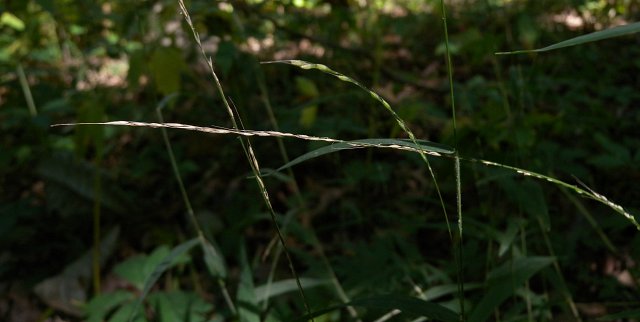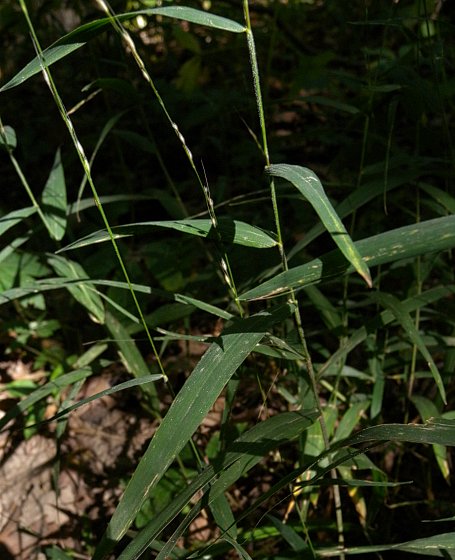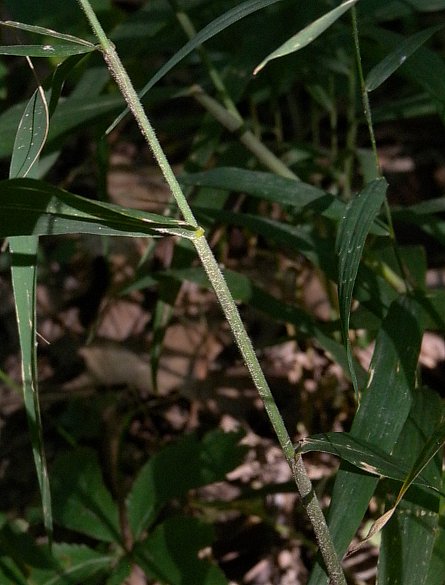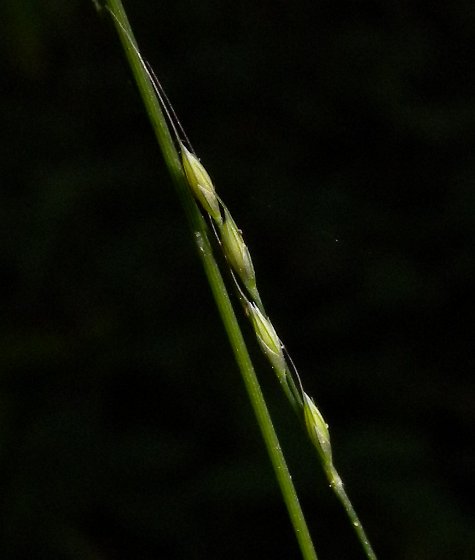
Each culm terminates in a panicle of spikelets about 3-10" long; because of its erect and appressed lateral branches, the panicle has a spike-like appearance. When the culm branches, sometimes 1-2 additional panicles of spikelets are produced, although these tend to be shorter. The lateral branches are up to 2" long. Both the rachis of the inflorescence and its lateral branches are slender, medium green, and slightly scabrous. The lateral branches terminate in spikelets with pedicels; these pedicels are up to ¼" (6 mm.) long. Individual spikelets are single-flowered and 3.0-3.5 mm. long, consisting of 2 glumes, an awned lemma, and a perfect floret. One glume is slightly longer than the other; they are 1.5-2.5 mm. long, lanceolate, and single-veined. The lemma is 3.0-3.5 mm. long (excluding its awn), linear-lanceolate or narrowly elliptic in shape, and obscurely 3-veined. The base of the lemma is conspicuously long-pubescent, but this characteristic is largely hidden by the glumes. The awn of the lemma is 3-10 mm. long and straight. Enclosed within the lemma is a perfect floret with a pair of feathery stigmata and 3 anthers. The blooming period occurs from late summer to early fall. The florets are cross-pollinated by the wind.

Afterwards, the spike-like panicle becomes light brown at maturity. Disarticulation of the mature spikelets is above the glumes. The pale grains are narrowly ellipsoid, light weight, and about 2 mm. long. The root system is fibrous and long-rhizomatous. Clonal colonies of plants are produced from the rhizomes.
Cultivation: The preference is light to medium shade, mesic to dry-mesic conditions, and soil containing loam, clay-loam, rocky material, or glacial till. The broad leaves of this grass enables it to tolerate shade relatively well.
Range & Habitat: Slender Satin Grass is occasional throughout Illinois, where it is native (see Distribution Map). Habitats include upland areas of hilly woodlands, rocky woodlands, upland savannas, bluffs, wooded slopes, and banks of rivers in shaded or semi-shaded areas. These wooded habitats are dominated by deciduous trees, especially oaks (Quercus spp.). This native grass is rarely found in open areas, at least in Illinois. It is associated with higher quality natural areas where the ground vegetation is relatively low or sparse, and where there is an absence of invasive shrubs.

Faunal Associations: Various insects feed on Slender Satin Grass (Muhlenbergia tenuiflora) and other Muhly grasses (Muhlenbergia spp.). These species include the aphids Anoecia cornicola and Schizaphis muhlenbergia, the leafhoppers Flexamia imputans and Plesiommata tripunctata, the plant bug Stenodema vicinum, larvae of the the gall flies Astictoneura agrostis and Astictoneura muhlenbergiae, larvae of the Chloropid fly Homaluroides ingratus, larvae of the Eurytomid wasp Eurytomocharis muhlenbergiae, and larvae of the leaf-mining moth Elachista brachyelytrifoliella. Larvae of the preceding flies form galls on the stems, while larvae of the preceding Eurytomid wasp deform the stems, of these grasses. Little is known about the relationship of these grasses to vertebrate animals, although their young foliage is edible to cattle and probably other hoofed mammalian herbivores. The awned lemmas of Slender Satin Grass suggest that these animals may also carry the seeds around on their fur, thereby spreading this grass to new areas.

Photographic Location: An upland area of a hilly woodland in east-central Illinois.
Comments: Generally, Muhly grasses (Muhlenbergia spp.) have not received that much attention from conservationists and members of the public as they are not particularly showy and can be difficult to identify. Perhaps the most striking feature of Slender Satin Grass (Muhlenbergia tenuiflora) is the long slender inflorescence, which can be up to 12" long. In addition to its narrow inflorescence, this grass can be distinguished from similar species by the long awns of its lemmas (3-10 mm. in length), its wider and shorter glumes, its pubescent sheaths, relatively broad leaf blades (up to 10 mm. across), and its unbranched or little-branched culms. Other Muhly grass species differ in one or more of these characteristics by having wider and shorter inflorescences, shorter awns or no awns on their lemmas, longer and more slender glumes, glabrous sheaths, more narrow leaf blades, and abundantly branched culms. Another common of Muhlenbergia tenuiflora is Slender Muhly Grass.